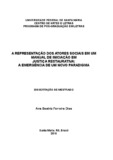| dc.creator | Dias, Ana Beatriz Ferreira | |
| dc.date.accessioned | 2010-03-12 | |
| dc.date.available | 2010-03-12 | |
| dc.date.issued | 2010-02-04 | |
| dc.identifier.citation | DIAS, Ana Beatriz Ferreira. The representation of the social actors in an initiation manual in Restorative Justice: the emergence of a new paradigm. 2010. 134 f. Dissertação (Mestrado em Letras) - Universidade Federal de Santa Maria, Santa Maria, 2010. | por |
| dc.identifier.uri | http://repositorio.ufsm.br/handle/1/9816 | |
| dc.description.abstract | As a new paradigm, restorative justice underlies a culture of peace, offering alternative means for a conflict resolution which can be applied not only on the legal
field, but also on the fields of community, education and family. Taking this into account, in this study we sought to answer the following question: in the Brazilian
context, how are the social actors represented linguistically in a didactic manual meant for the formation of social agents able to coordinate restorative justice practices? The main purpose of this work is to analyze the forms of representation of the social actors expressed in a manual of restorative justice. Thus, we based our corpus study on the manual Initiation in Restorative Justice: subsidies of restorative practices for conflict transformation (2006), which was used in the design activities of the Gaucho Project Justice for the 21st Century. Through the theories of discourse genres, we selected for the linguistic analysis the statements from the manual that belong to a guideline aimed to help the implementation of Restorative Procedures. Based on Bakhtinian assumptions, we analyzed the linguistic forms inserted in a specific socio-historical context. We conducted a socio-historical analysis of the most
immediate and wider context which involve the production of the manual, and analyzed the forms of representation of the social actors based on the categories developed by van Leeuwen (1997). In this study, we verified that the linguistic choices produced in a certain context reflect a dialogic tension between distinctive realities. The analysis showed that the representations of the social actors indicate a reality constructed according to the ideals of the restorative paradigm. However, certain representations move away from these ideals. From our point of view, the language reveals that restorative justice during this initial stage of implementation
has been promoting dialogue with other world visions as an attempt to establish itself as a paradigm. | eng |
| dc.description.sponsorship | Coordenação de Aperfeiçoamento de Pessoal de Nível Superior | |
| dc.format | application/pdf | por |
| dc.language | por | por |
| dc.publisher | Universidade Federal de Santa Maria | por |
| dc.rights | Acesso Aberto | por |
| dc.subject | Linguagem | por |
| dc.subject | Representações sociais | por |
| dc.subject | Atores sociais | por |
| dc.subject | Justiça
restaurativa | por |
| dc.subject | Language | eng |
| dc.subject | Social representations | eng |
| dc.subject | Social actors | eng |
| dc.subject | Restorative justice | eng |
| dc.title | A representação dos atores sociais em um manual de iniciação em justiça restaurativa: a emergência de um novo paradigma | por |
| dc.title.alternative | The representation of the social actors in an initiation manual in restorative justice: the emergence of a new paradigm | eng |
| dc.type | Dissertação | por |
| dc.description.resumo | Como um novo paradigma, a justiça restaurativa fundamenta-se em uma cultura de paz, oferecendo meios alternativos para a resolução de conflitos que podem ser aplicados não apenas no campo jurídico, mas também no comunitário, educacional e familiar. A partir disso, buscamos responder, com este estudo, a seguinte pergunta: no contexto brasileiro, como os atores sociais são representados linguisticamente em um manual didático voltado para a formação de agentes sociais
capazes de coordenar práticas de justiça restaurativa? O objetivo principal deste trabalho é analisar as formas de representação dos atores sociais expressas em um
manual de justiça restaurativa. Para tanto, tomamos como corpus o manual Iniciação em Justiça Restaurativa: subsídios de práticas restaurativas para a transformação de conflitos (2006), utilizado nas atividades de formação do projeto gaúcho Justiça para o Século 21. Selecionamos para a análise linguística os enunciados do manual que pertencem a um roteiro destinado a orientar a realização de Procedimentos
Restaurativos, pelo viés das teorias de gêneros discursivos. Com base nos pressupostos bakhtinianos, analisamos as formas linguísticas inseridas em determinado contexto sócio-histórico. Realizamos uma análise sócio-histórica do
contexto mais imediato e do mais amplo que envolve a produção do manual e analisamos as formas de representação dos atores sociais com base nas categorias elaboradas por van Leeuwen (1997). Por meio deste estudo, verificamos que as escolhas linguísticas, produzidas em dado contexto, refletem uma tensão dialógica entre realidades distintas. A análise mostrou que as representações dos atores
sociais apontam, na maioria das vezes, para uma realidade construída de acordo com os ideais do paradigma restaurativo. Contudo, certas representações distanciam-se desses ideais. A nosso ver, a linguagem revela que a justiça
restaurativa, durante esse seu período inicial de implantação, vem dialogando com outras visões de mundo, como uma tentativa de estabelecer-se como um paradigma. | por |
| dc.contributor.advisor1 | Pires, Vera Lúcia | |
| dc.contributor.advisor1Lattes | http://buscatextual.cnpq.br/buscatextual/visualizacv.do?id=K4103630D3 | por |
| dc.contributor.referee1 | Silveira, Regina da Costa da | |
| dc.contributor.referee1Lattes | http://buscatextual.cnpq.br/buscatextual/visualizacv.do?id=K4797421Y6 | por |
| dc.creator.Lattes | http://buscatextual.cnpq.br/buscatextual/visualizacv.do?id=K4487974T9 | por |
| dc.publisher.country | BR | por |
| dc.publisher.department | Letras | por |
| dc.publisher.initials | UFSM | por |
| dc.publisher.program | Programa de Pós-Graduação em Letras | por |
| dc.subject.cnpq | CNPQ::LINGUISTICA, LETRAS E ARTES::LETRAS | por |


